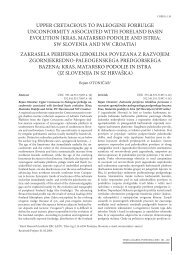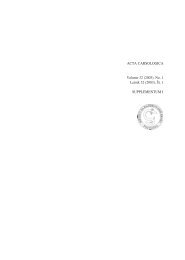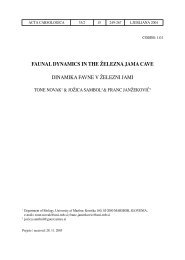Download pdf - Acta Carsologica - ZRC SAZU
Download pdf - Acta Carsologica - ZRC SAZU
Download pdf - Acta Carsologica - ZRC SAZU
- No tags were found...
Create successful ePaper yourself
Turn your PDF publications into a flip-book with our unique Google optimized e-Paper software.
Tanja PIPAN, Vesna NAVODNIK, Franc JANŽEKOVIČ, Tone NOVAKFig. 2: Ground plan of the passage Medvedji rov in the Huda luknja cave system showing sampling sites; acc. to Ravljen (1986, 1989),completed by R. Bračič and M. Podpečan. Fig.cal analyses were transported in the laboratory whereconcentrations of cations (sodium, potassium, calciumand magnesium) and anions (chloride, sulphate and nitrite)as well as calcium and total hardness were determinedusing Standard Methods for the Examination ofWater and Wastewater (1989). The samples of fauna werein situ fixed with the formaldehyde until the final solutionof 2−3%. Organisms were extracted and identifiedusing a microscope (Olympus CH30) and stored in 70%ethanol.Descriptive statistics was used to describe physicaland chemical characteristics of the drips. The correlationbetween fauna assemblages and physical and chemicalparameters of percolation water was performed calculatingPearson coefficient. One-way ANOVA was used intesting differences between the drips and the samplingdates in each physical and chemical parameter. In testingcommunities, the Simpson index of dominance (D) (1)and the Shannon-Weaver diversity index (H’) (2) werecalculated separately for each drip in the whole year. ThePearson correlation between D and H’, and the distancefrom the entrance and the surface, respectively, was calculatedfor all 12 drips. The Jaccard similarity coefficient(S J) (3) was calculated separately for aquatic and terrestrialtaxa to evaluate similarities of these communities indifferent drips (Legendre & Legendre 2003):D=1−∑ (n 2− iN )n in iH’=−∑−ln−N NS J =− aa+b+c(1)(2)(3)where n iis the number of individuals belonging to speciesi, N the total number of individuals, a the number ofcommon species in both drips (joint occurrence), b thenumber of species in one drip but not in the other, and cthe number of species in the second drip but not in thefirst one. The Jaccard index values were compared amongeach other using the Mantel t-test (program MANTELfor Windows), and the comparison of the index valuesbetween water and terrestrial taxa was performed as well.The program SPSS 11.0 was used in the statistical procedures.RESULTSThe descriptive statistics of the physical and chemicalparameters is presented in Table 1. Considering thewhole year, there were significant differences betweensampling sites in each physical and chemical parameter(F 11, 266= 1.90, p = 0.039 for pH and F 11, 266= 2.41,p = 0.007 for temperatures, and F 11, 266= 5.10−71.73,p
FIRST STUDIES OF THE FAUNA OF PERCOLATION WATER IN HUDA LUKNJA, A CAVE IN ISOLATED KARST IN SLOVENIATable 1: Basic environmental parameters of twelve sampled drips in Huda luknja (NE Slovenia), monthly sampling from November 2005 till October 2006.Drip number /ParameterTemperature(°C)1 2 3 4 5 6 7 8 9 10 11 127.8±1.0(5.5−9.9)pH 8.1±0.3(7.5−8.3)Conductivity(µScm -1 )Ca hardness(mEql -1 )Total hardness(mEql -1 )247.0±38.7(128.0−294.0)2.6±0.1(2.4−2.9)2.9±0.2(2.5−3.3)Na + (mgl -1 ) 0.7±0.1(0.6−1.0)K + (mgl -1 ) 1.2±0.3(0.3−2.0)7.4±1.4(4.3−9.5)7.9±0.3(7.6−8.4)225.1±53.8(135.0−319.0)2.9±0.2(2.7−3.5)1.0±0.2(0.6−1.3)0.5±0.1(0.4−0.7)8.0±1.1(4.7−9.5)8.0±0.3(7.4−8.4)284.1±55.3(188.0−371.0)3.6±0.3(2.3−3.8)3.9±0.2(3.3−4.2)0.8±0.1(0.6−0.9)0.7±0.5(0.4−2.1)6.9±1.5(4.5−9.4)8.1±0.2(7.7−8.3)209.3±49.9(119.0−276.0)2.1±0.1(2.0−2.2)2.4±0.1(2.2−2.6)0.5±0.1(0.4−0.8)0.4±0.1(0.3−0.6)7.6±1.8(5.4−10.3)8.1±0.2(7.7−8.3)181.9±37.2(120.7−226.0)2.1±0.1(2.0−2.3)2.4±0.1(2.2−2.7)0.6±0.1(0.4−0.8)0.3±0.1(0.2−0.5)7.2±0.9(5.6−8.2)7.9±0.1(7.7−8.2)192.3±44.4(127.6−245.0)2.3±0.2(2.0−2.8)2.5±0.2(2.2−3.0)0.8±0.1(0.6−1.0)1.0±0.3(0.4−1.8)7.1±1.0(5.2−8.2)8.1±0.2(7.8−8.4)228.9±53.3(149.0−304.0)2.7±0.3(2.4−3.2)2.9±0.3(2.7−3.5)0.8±0.2(0.5−1.4)0.6±0.2(0.3−1.1)7.2±0.7(6.2−8.1)8.1±0.2(7.8−8.4)252.4±60.9(145.2−330.0)2.7±0.5(2.0−3.3)2.9±0.5(2.2−3.6)0.7±0.3(0.5−1.5)0.5±0.4(0.3−2.0)7.2±1.2(3.7−8.1)8.1±0.2(7.7−8.3)209.4±49.7(123.4−295.0)2.3±0.2(1.8−2.6)2.7±0.2(2.2−3.0)0.9±0.1(0.7−1.2)0.5±0.2(0.4−0.9)7.5±0.3(7.0−7.9)7.9±0.1(7.6−8.2)280.9±65.6(176.6−345.0)2.5±0.8(1.6−3.7)3.1±0.4(2.7−3.8)0.9±0.1(0.8−1.2)0.3±0.2(0.2−0.7)7.7±0.2(7.0−8.1)8.0±0.1(7.9−8.3)209.5±35.7(144.2−318.0)2.7±0.2(2.1−3.4)3.1±0.2(2.4−3.6)1.0±0.1(0.7−1.2)0.2±0.1(0.1−0.9)7.6±0.4(7.0 −8.2)8.0±0.2(7.7−8.3)221.4±46.9(152.0−284.0)2.7±0.3(2.0−3.2)2.9±0.3(2.6−3.5)0.9±0.1(0.8−1.2)0.4±0.3(0.3−1.4)Ca + (mgl -1 ) 39.1±14.3(2.2−52.1)Mg + (mgl -1 ) 0.2±0.1(0.0−0.6)-NO 3(mgl -1 ) 20.5±7.2(3.1−30.9)2-SO 4(mgl -1 ) 13.9±2.7(8.6−21.5)Cl - (mgl -1 ) 1.0±0.3(0.9−1.4)19.9±13.9(2.3−52.1)0.3±0.1(0.1−0.4)13.3±4.4(4.9−21.5)19.1±4.2(10.1−23.5)1.2±0.2(0.8−1.6)30.5±18.3(3.2−76.2)0.3±0.3(0.1−1.0)16.5±18.1(3.5−65.5)16.7±2.9(8.6−20.6)1.4±0.3(0.8−1.9)26.5±13.1(1.7−44.1)0.3±0.1(0.1−0.4)12.6±3.8(0.0−15.8)9.6±3.3(0.0−13.8)0.9±0.3(0.3−1.6)20.9±8.8(1.8−44.1)0.3±0.1(0.1−0.6)2.9±0.2(2.5−3.3)11.1±1.7(8.4−13.5)0.9±0.1(0.9−1.3)24.0±11.7(1.8−48.1)0.2±0.2(0.0−0.5)14.7±4.8(1.3−19.2)12.9±3.1(8.5−19.4)0.9±0.2(0.8−1.3)26.5±9.6(2.4−50.1)0.3±0.2(0.0−0.7)3.9±1.6(1.5−5.9)14.5±4.0(7.9−20.0)1.2±0.2(0.9−1.6)26.8±11.4(2.5−54.1)0.3±0.2(0.0−0.6)2.7±1.7(0.5−4.8)13.2±4.8(6.9−20.5)1.2±0.3(0.8−1.5)24.2±10.1(2.5−48.1)0.4±0.2(0.0−1.0)2.4±2.5(0.8−10.3)13.9±2.9(9.8−17.6)1.3±0.3(0.9−1.9)30.5±13.6(2.8−74.2)0.6±0.5(0.0−1.3)1.1±0.2(0.8−1.6)12.9±3.3(9.3−18.2)1.2±0.2(0.9−1.6)9.5±12.6(2.3−52.1)0.3±0.1(0.0−0.4)0.9±0.6(0.4−4.3)15.2±2.7(7.8−16.6)1.3±0.2(0.8−1.4)25.2±10.8(2.4−52.1)0.3±0.2(0.0−0.6)5.8±5.9(0.0−23.9)17.5±4.0(10.1−22.5)1.2±0.2(0.9−1.6)Table 3: Number of copepod species per cave, and abundance of copepods, other aquatic species, and terrestrial species per sample. Number of species per cave and number of speciesper sample have a complex connection (Pipan & Culver 2007), and cannot be determined simply by dividing the two. Data from present study (Huda luknja) and Pipan (2005, all othercaves).Huda luknja Postojnska jama Pivka jama Črna jama Škocjanske jame Dimnice Županova jamaNumber of copepod species 2 5 11 8 9 8 14Number of copepods/sample 0.4 1.1 120.2 58.2 47.6 12.2 63Number of other aquatics/sample 3.5 1.6 38.4 8.8 57.4 19.4 29.4Number of terrestrials/sample 6.5 1.1 2.2 3.8 1.6 1.6 1.4ACTA CARSOLOGICA 37/1 – 2008 145
Tanja PIPAN, Vesna NAVODNIK, Franc JANŽEKOVIČ, Tone NOVAKTable 2: List of taxa found in twelve drips during a one year sampling from November 2005 till October 2006 in Huda luknja (NESlovenia)*.HIGHER GROUP CLASS ORDO FAMILY GENUS and/or SPECIESA amphibic, T terrestrial, AQ aquatic taxonNEMATODA RHABDITIDA unidentified, AQANNELIDA CLITELLATA OLIGOCHAETA Enchytraeidae unidentified, AQLumbricidaecf. Dendrobaena sp., AARTHROPODA ARACHNIDA PALPIGRADI Eukoeneniidae Eukoenenia cf. austriaca, T(a tail fragment)ARANEAE Linyphiidae Troglohyphantes diabolicus, TACARINA Ixodidae Ixodes vespertilionis, T **MESOSTIGMATAORIBATIDAunidentified, Tunidentified, TAMPHIPODA Niphargidae Niphargus scopicauda, AQOSTRACODAunidentified, AQCOPEPODA HARPACTICOIDA Parastenocarididae Parastenocaris nolli alpina, AQCHILOPODACanthocamptidaeBryocamptus balcanicus, AQunidentified, TDIPLOPODA ACHEROSOMATIDA unidentified, TINSECTAENTOGNATHAAttemsiidaePolyphematia moniliformis, TCOLLEMBOLA Poduridae unidentified, TSminthuridaeEntomobryidaeunidentified, Tunidentified, TDIPLURA Campodeidae Plusiocampa sp., TPTERYGOTACOLEOPTERA Staphylinidae cf. Atheta sp., TCarabidaeCurculionidaeLaemostenus (Antisphodrus) schreibersi, TOtiorhynchus (Troglorhynchus) anophthalmus TDIPTERA Sciaridae unidentified, TMUSCOMORPHA*Eggs, coccons and rests of undetermined taxa not included. **Parasitic.Trichoceridaeunidentified, Tunidentified larva, TIn all the twelve drips we found 132 individuals and67 eggs, respectively, belonging to 6 aquatic, 1 amphibiousand 18 terrestrial invertebrate taxa (Table 2). Amongthese taxa, there are species which inhabit the hypogean,soil and epigean environments. Number of individualswas in significant positive correlation with K + (r = 0.64,p = 0.026) and NO 3- (r = 0.69, p = 0.013). There wereno correlation between the numbers of individuals, D,H’, and the distance from the entrance and the surface(p>0.05) in the dataset of all 12 drips. The 11 th drip is theoutput of a passage more or less directly connected withthe surface. With respect to the presence there were nospecific dispersion patterns neither in aquatic not in theterrestrial taxa therefore the Jaccard index dendrogramsare not presented here. There were also no significantcorrelation between the values of the Jaccard index and itwas also the case in the comparison of the aquatic againstthe terrestrial taxa (r = -0.08; Mantel t-test, t = -0.54, p =0.294). While the other taxa appeared in the drips moreor less randomly, the only exception is the lumbricid species,present solely in drip No. 3.The most abundant taxa represented by ten or moreindividuals were oligochaetes from the families Enchytraeidaeand Lumbricidae (Fig. 3), and eggs of undeterminedorganisms. Both the aquatic Enchytraeidae andamphibious Lumbricidae were the most abundant in thewarm period of the year, while the newly-hatched enchytraeidswere caught in January, after heavy raining. The146ACTA CARSOLOGICA 37/1 – 2008
Tanja PIPAN, Vesna NAVODNIK, Franc JANŽEKOVIČ, Tone NOVAKpossible to compare species richness. Median numberof terrestrial invertebrates per drip was 1.6 for the karstcaves and 6.5 for Huda luknja (Table 3). This tantalizingdata suggests that with increasing depth there may alsobe increasing amounts of terrestrial habitat. If it is theepikarst and not the column of percolating water that isthe primary habitat as most evidence indicates (Culver& Pipan 2005, but see Sket et al. 2004a), then the cracksand fissures of the zone of percolation harbors a terrestrialfauna (as indicated by presented data), and acts as afilter as indicated by the importance of ceiling thickness(Pipan et al. 2006a, b).The distribution and the development of subterraneanfauna depend on geomorphologic and hydrologicconditions since the Pliocene (Bole 1977). The idea thatcaves of various isolated karst patches could offer an opportunityfor studying evolutionary and biogeographicprocesses in the hypogean fauna, especially molluscs(Bole 1972), has not been confirmed. It now seems thatthis idea can be resurrected by referring to the epikarstfauna. Distribution of fauna in the epikarst which islargely ruled by local conditions is in close relation withthe hydrogeological characteristics of epikarst, controlledby hydraulic connectivity (Pipan & Culver 2007).For some subterranean organisms it was found out thattheir reproduction is induced by decreasing temperatureand increasing flux of organic material (Culver et al.1995). We can assume that the enchytraeids with theirnewly hatched juveniles in November are representativesof such a species well adapted to the hypogean environments.The new lumbricid species, found only in the dripNo. 3 whose water characteristics differed considerablyfrom other drips especially by higher nitrate concentration,deserve a special treatment elsewhere. The positivecorrelation between number of individuals and K + andNO 3- probably concerns their special nutritional value,but any further conclusion would be speculative. Pipanet al. (2006a) discuss a similar example of exclusivepresence among copepods in percolation water as somespecies were found only in one drip in a cave. This wasbest explained as representing extreme environmentalconditions in the cave. Niphargus scopicauda probablyderived from unknown water courses above the cave,while the two harpacticoid species are from the epikarst.Bryocamptus balcanicus shows troglomorphic characterswhile Parastenocaris nolli alpina with its slim body prefersinterstitial habitats and crevices of the unsaturatedzone where it most easily escapes from being preyed byvarious predators. It is often found in small depressionson cave walls but not in larger pools (Petkovski 1959,Pipan 2005). Groups of animals found in percolationwater are common in many other subterranean habitats(Moldovan et al. 2007), but some stygobiotic speciesfrom drips are specialized for particular microhabitatsand often represent endemic taxa (Pipan 2005). So far,perhaps except for the enchytraeid species, all the othersin the Medvedji rov seem to belong to representativesof taxa sharing various habitats. Negative correlations ofD and H’ with conductivity, and with total hardness andCa 2+ probably indicate that the individuals in drips weremostly eluted into the passage by water relatively rapidlypercolating through the limestones, although this resultcould also be coincidental.The significant differences in the physical andchemical properties between the drips indicate heterogeneousnature of the habitats supplying water to thedrips. According to their terrestrial and aquatic taxa assemblagesthe drips are fed with the percolation waterfrom the surface, from fissures and larger undiscoveredpassages above the Medvedji rov. In general, the epigean,epikarst and hypogean faunas were present in the drips,although fauna in the drips is relatively very poor ascompared with the one in the Dinaric and Alpine karst(Pipan 2005; unpublished data), especially with respectto the phreatic taxa.The biodiversity of a particular cave is governedby physical and ecological heterogeneity in the epikarstwhich influence the biotic diversity in the lower unsaturatedzone (Pipan 2005, Moldovan et al. 2007). In principle,such taxa also present an important source of particulateorganic carbon (POC) entering a cave throughthe epikarst (Simon at al. 2007). In our case, all three:the epigean, the epikarstic and the hypogean terrestrialas well as aquatic taxa contributed to the biotic diversityof the drips, but little to the input of organic matter. Subterraneanbiodiversity is at the local scale controlled byproductivity (Gibert & Deharveng 2002). The very limitedamount of POC could be one of the reasons for thespecies scarcity in the area. The limited POC, the driftedindividuals of terrestrial hypogean taxa as well as relativelylow concentrations on N and P compounds in mostdrips suggest that sudden pouring with the rain water arethe crucial factor for drifting fauna into the cave passage.The decrease of biodiversity from the first toward the lastsampling site was found in some previous studies of anepikarst fauna from Slovenian caves (Pipan 2005, Pipanet al. 2006a), and as is the case in Medvedji rov indicateshaphazardous influx of individuals from various habitatsabove the passage.148ACTA CARSOLOGICA 37/1 – 2008
FIRST STUDIES OF THE FAUNA OF PERCOLATION WATER IN HUDA LUKNJA, A CAVE IN ISOLATED KARST IN SLOVENIACONCLUSIONSOn the basis of the fauna assemblages composed of terrestrialand aquatic taxa, it is concluded that samplesfrom Huda luknja are fed by the percolation water fromthe surface, from fissures and larger undiscovered passagesabove the Medvedji rov. Both the aquatic as wellas the terrestrial taxa were randomly distributed in thedrips irrespective of the physical and chemical propertiesof water. In general, the epikarst aquatic fauna of thePaka isolated karst is relatively poor. At the moment, itcan not be concluded whether this is a general phenomenonin the isolated karst concerning its all-over bioticpoverty or it is a specific characteristic of each isolatedkarst patches, like the Paka karst. More adequate knowledgeon the topic must be acquired in the isolated karstto make the decision.ACKNOWLEDGEMENTSWe are indebted to the staff of the chemical laboratory ofthe Steam Power Station Šoštanj where the chemical analyseswere carried out, especially to Mrs. Greta Srnovršnik.We are grateful to the cavers of the Cavers’ Club Speleos– Siga in Velenje for the support in the investigations andto Viktor Ocvirk for the help with the field work. BorisSket and Cene Fišer determined the Niphargus specimens.We thank Janez Ravljen, Rajko Bračič and MilanPodpečan for the permission of publishing the plans ofHuda luknja. We sincerely thank Janez Mulec and DavidCulver for critical remarks and insightful comments onthe manuscript. David Culver is thanked for his constructivereview of the manuscript that included helpfulsuggestions and Table 3 that improved the value of thefinal paper. The study was partly supported by the SloveneMinistry of High Education, Science and Technologywithin the Biodiversity research programme (P1-0078).REFERENCESBakalowicz, M., 2004: The epikarst, the skin of karst. In:Jones, W. K., D. C. Culver, & J. S. Herman (eds.) Proceedingsof the “Epikarst” Symposium, October 1-4,2003, Sheperdstown, West Virginia, USA, Karst WatersInstitute Special Publication 9, pp. 16−22.Bole, J., 1972: Podzemeljski polži na osamljenem krasuSlovenije.- Naše jame, 13, 55−59.Bole, J., 1977: Podzemeljski polži v osamljenem krasuPosavskega hribovja.- Naše jame, 18, 31−38.Bole, J., 1985: Recentni podzemeljski polži in razvojnekaterih porečij na dinarskem krasu.- Razprave(Dissertationes), classis IV, <strong>SAZU</strong>, 24, 315−328.Brodar, M.,1993: Paleolitske in mezolitske najdbe iz jameŠpehovke pri Zgornjem Doliču.- Arheološki vestnik,44, 7−28.Brodar, S., 1938: Das Paläolitikum in Jugoslawien.-Quartär, 1, 140−172+VII.Camacho, A. I., A. G. Valdecasas, J. Rodríguez, S. Cuezva,J. Lario, & Sánchez-Moral, S., 2006: Habitat constraintsin epikarstic waters of an Iberian Peninsulasystem cave.- Annales de Limnologie-InternationalJournal of Limnology, 42, 2, 127−140.Culver, D. C., T. C. Kane, & Fong, D. W., 1995: Adaptationsand natural selections in caves: the evolutionof Gammarus minus.- Harvard University Press, p.233, Cambridge.Culver, D. C., M. C. Christman, W. R. Elliott, H. H. HobbsIII, & Reddell J. R., 2003. The North American obligatecave fauna: regional patterns.- Biodiversity andConservation, 12, 441-468.Culver, D. C. & Pipan, T., 2007: What does the distributionof stygobiotic Copepoda (Crustacea) tell usabout their age?- <strong>Acta</strong> carsologica, 36, 87−91.Culver, D. C. & Pipan, T., in press: Caves as Islands.- InG. Rice [ed.] Encyclopedia of Islands, University ofCalifornia Press, Berkeley.Fong, D. W., D. C. Culver, H. H. Hobbs III, & Pipan, T.,2007: The invertebrate cave fauna of West Virginia,Second edition.- West Virginia Speleological Survey,Bulletin No. 16, p. 163, Barrackville.Gams, I., 2004: Kras v Sloveniji v prostoru in času.-Inštitut za raziskovanje krasa <strong>ZRC</strong> <strong>SAZU</strong>, p. 515,Ljubljana.ACTA CARSOLOGICA 37/1 – 2008 149
FIRST STUDIES OF THE FAUNA OF PERCOLATION WATER IN HUDA LUKNJA, A CAVE IN ISOLATED KARST IN SLOVENIASket, B., K. Paragamian, & Trontelj P., 2004b: A census ofthe obligate subterranean fauna of the Balkan Peninsula.In: Griffiths, H. I., B. Kryštufek, & Reed, J.M. (eds.) Balkan Biodiversity. Pattern and Process inthe European Hotspot, Kluwer Academic Publishers,Dordrecht, pp. 309−322.SPSS 11.0 for Windows.Standard Methods for the Examination of Water andWastewater, 17 th edition, 1989.- APHA-AWWA-WPCF, p. 1088 p.Trontelj, P., Š. Gorički, S. Polak, R. Verovnik, V. Zakšek, &Sket, B.,: 2007: Age estimates for some subterraneantaxa and lineages in the Dinaric karst.- <strong>Acta</strong> carsologica,36, 183−189.Zagmajster, M. & Kováč, L., 2006: Distribution of palpigrades(Arachnida, Palpigradi) in Slovenia witha new record of Eukoenenia austriaca (Hansen,1926).- Natura Sloveniae, 8(1), 23−31.ACTA CARSOLOGICA 37/1 – 2008 151







